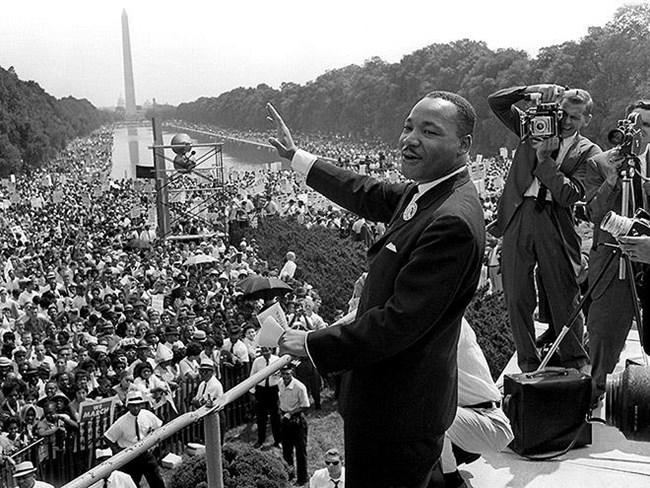Last updated: January 12, 2024
Article
Living the Dream: The Promise of Brown v. Board of Education and Martin Luther King Jr.

Courtesy Photo: Library of Congress
A new leader, a 26-year-old preacher from Atlanta, Georgia in his second year as pastor at the Dexter Avenue Baptist Church, emerged in December 1955 from Montgomery, Alabama. Martin Luther King Jr. organized a citywide bus boycott in support of Rosa Parks for refusing to obey segregation laws on public buses.
The boycott lasted over a year and King became the new leader in the push for desegregation in all parts of society. His use of nonviolent techniques and his ability to motivate thousands of people through rhetoric made him an unprecedented force in the fight for civil rights in America.
In his December 15, 1956, speech, King called the Brown decision, “…one of the most momentous decisions ever rendered in the history of this nation…” and it was a “…reaffirmation on the good old American doctrine of freedom and equality for all men.” However, he also stated that “…segregation is already legally dead, but it is factually alive.” According to King, the promise of Brown v. Board of Education would not be fulfilled until all forms of segregation were erased from society.
King believed the promise of Brown was more than an end to legal segregation. Instead, King announced in a May 17, 1956, speech that the promise of Brown was “personal and social integration.” Personal and social integration is not a legal process, it is only a personal and voluntary behavior to integrate without the force of law.
In a speech commemorating the second anniversary of the Brown v. Board of Education decision, he declared Brown was about more than equal education, it created an era where “… all men will live together as brothers, and where every man recognizes the dignity and worth of all human personality.” However, King was not an irrational optimist, he understood there was, and still is, work that must be done to accomplish the promise of Brown.
On August 28, 1963, Martin Luther King Jr. shared his dream with America about the future of American race relations. Standing in front of the Lincoln Memorial, King announced his hope that “…my four little children will one day live in a nation where they will not be judged by the color of their skin but by the content of their character.” The dream King hoped for was a society that fulfilled the promise of Brown. The promise of an end to racial segregation, prejudice, and injustice.
The technique used by King to help achieve his dream was nonviolence. King explained how nonviolence worked by “refus[ing] to hit back will cause the oppressors to become ashamed of their own methods and we will be able to transform enemies into friends.” Nonviolence can be used in the absence of violence too. By showing brotherly love to everyone in society you are participating in nonviolence as well.
January 15 is a national holiday dedicated to the life and memory of Dr. Martin Luther King Jr. It is important to remember on this day what King accomplished for humanity during his lifetime, but it is more important to help King’s dream become a reality. King’s dream of a society where people not judged by race can be accomplished and the promise of Brown will be fulfilled by celebrating Martin Luther King Jr. Day every day.
